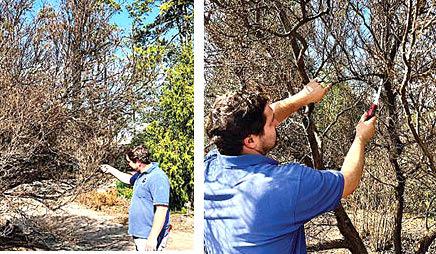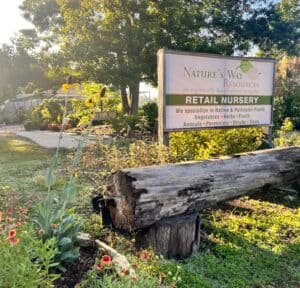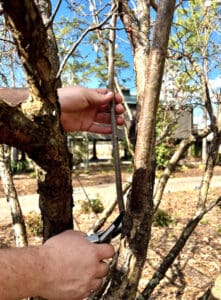 Nature’s Way Resources is proud to produce & email you this free weekly newsletter. We have no ads, but sponsors do graciously help support this project as a public service. Please note their names below & show your gratitude for this free service by patronizing their businesses! To become a sponsor, call (936) 273-1200
Nature’s Way Resources is proud to produce & email you this free weekly newsletter. We have no ads, but sponsors do graciously help support this project as a public service. Please note their names below & show your gratitude for this free service by patronizing their businesses! To become a sponsor, call (936) 273-1200
Nature’s Way Resources owner John Ferguson, “The Lazy Gardener” Brenda Beust Smith and Pablo Hernandez welcome your feedback and are so grateful to the many horticulturists who contribute their expertise
Click here to join our email list
CLICK HERE for PDFs OF PAST LG&F NEWSLETTERS
“Ok, longtime Houston gardeners, lets tell
newbies to gardening here, how important it is
to use GREATER HOUSTON AREA ADVICE!” — Oft-repeated quote, origin not credited

TIME TO PRUNE, BUT DO IT RIGHT! MERCER’S TIPS BELOW
WHAT A FRUSTRATING GARDENING PERIOD THIS MONTH!
BY BRENDA BEUST SMITH
We want to garden! Sun was out, we were into sleeveless shirts, rains have been sufficient, nurseries are PACKED with gorgeous flowers. Everyone’s thinking GARDENING!!! This current rain is a good thing, cold iffy. Plant roots below ground are itchin’ to shoot green growth upward!. Rainwater will make them healthier. Wondering what you should do first?
DON’T POUT — TURN ON RADIO! Used to have many gardening radio shows. Now only know of two, but both have excellent hosts and experienced LOCAL guest experts. Be patient! Don’t hesitate to call if you have queries!
- GARDEN LINE WITH SKIP RICHTER, 740AM KTRH — Saturday & Sunday, 6–10 AM. Call in line:713-212-5874. (Also on Heart Radio app.)
- HOME SHOW GARDENING PROS with TOM TYNAN, SPORTS RADIO Saturdays, Sat. 7-9am. Call-in line: 281-833-3333
Know of any others specifically for our area? Do share! Always check out-of-Greater Houston-Area against a LOCAL source. One size fits all doesn’t work for all! https://homeshowgardenpros.com/
 Since another cold spell’s ahead, good time to think about where to put colorful new bloomers. Check Texas hot sun tolerance! In blasting hot sunny areas, pale pastels may wash out, variegated plants may look like dying if used all alone. Strong solid greens, reds, oranges, yellows, etc. may compete better.
Since another cold spell’s ahead, good time to think about where to put colorful new bloomers. Check Texas hot sun tolerance! In blasting hot sunny areas, pale pastels may wash out, variegated plants may look like dying if used all alone. Strong solid greens, reds, oranges, yellows, etc. may compete better.- Less-than-preferable views in backyard? Use hot colored plants to draw visitor’s eye to more attractive off-site view from house, patio, etc.
- Color’s impact multiplies when coupled with hardscapes (rocks, birdbaths, fences, benches, etc.). Large rocks draw the eye, anchoring us to Mother Earth offering sort of a strong metaphysical protection from the stresses of everyday life. Locate at least one large interesting rock somewhere near the site where you sit outside at night.
- If you’re new to a subdivision with HOA/POA regulations about gardening in the front (and sometimes back) yard, be sure to check these before spending a lot of money on plants. Sometimes these are VERY strict.
(Above quoted Lazy Gardener Guide’s advice no longer in print. For pdf version, email lazygardenerbrenda@gmail.com)

 ATTN. GARDEN/PLANT GROUPS — In wake of Hurricane Beryl, Nature’s Way Resources offers free guided tours of NWR’s extensive nursery/soil/mulch facilities for garden clubs, plant societies and other plant-oriented, organized groups. As usual, NWR’s now-expanded meeting site is free to above groups. Reservations a must for both.
ATTN. GARDEN/PLANT GROUPS — In wake of Hurricane Beryl, Nature’s Way Resources offers free guided tours of NWR’s extensive nursery/soil/mulch facilities for garden clubs, plant societies and other plant-oriented, organized groups. As usual, NWR’s now-expanded meeting site is free to above groups. Reservations a must for both.
 2025 COLOR OF THE YEAR! Pantone picked this color “…rich, warming brown hue” because “M0CHA MOUSSE” is “supposed to evoke feelings of comfort and indulgence, such as those associated with chocolate and coffee, to feed our desire for harmony”!
2025 COLOR OF THE YEAR! Pantone picked this color “…rich, warming brown hue” because “M0CHA MOUSSE” is “supposed to evoke feelings of comfort and indulgence, such as those associated with chocolate and coffee, to feed our desire for harmony”!
Pictured: Cosmos Atrosanguineus
I actually knew someone who waited every spring to put in her new spring garden until Pantone announced its “Color of the Year.” Not sure how she’d have done it this year. Don’t find many ‘brown” blooms around these days!
Brenda Beust Smith’s column is based on her 40+ years as the Houston Chronicle’s “Lazy Gardener” column — lazygardenerbrenda@gmail.com Brenda’s column focuses ONLY on the Greater Houston Area
Spotlighting
MERCER BOTANIC GARDEN

Above. JACOB MARTIN, Mercer Botanic Garden Head of Horticulture/Greenhouse Manager notes: (left) On the Elm, which has naturally dense foliage, he shows cutting a branch that is crossing other branches, and if left to continue to grow, will eventually rub and damage the larger branch to the left. Right Jacob cuts an apricot branch with a saw, and at an angle to protect the branch collar. Christy Jones photos
 DON’T JUST ‘WHACK-AWAY’!
DON’T JUST ‘WHACK-AWAY’!
HAVE A TREE-PRUNING PLAN AND DO IT NOW!
by CHRISTY JONES
Mercer Botanic Garden
Education Director
We are in ‘late-winter’ pruning time that needs to be done before it gets too hot. Bugs and diseases get more active with heat. Give your tree time to adjust through Houston’s typical quick spring season.
First, you must have a goal – possibly to improve shape and health. Next, develop a plan – ours for smaller trees is to ensure balance and encourage healthy growth. Of course, we will remove any dead or broken limbs. Then, we use sharp, clean pruning shears, loppers, or saw depending on the size of branch.
Overall, we don’t want to trim more than 25% of the living crown of a tree at one time. Also, the shape should not resemble a ‘lollypop’ as this creates a top-heavy, thin tree that will be structurally weak and apt to blow over more easily in windstorms.
Pictured illustrate Jacob demonstrating trimming on two smaller ornamental trees: a White Flowering Apricot and Dwarf Chinese Elm.
Jacob shows how to prune two smaller trees with hand tools. We are in ‘late-winter’ pruning time that needs to be done before it gets too hot. Bugs and diseases get more active with heat so give your tree time to adjust through Houston’s typical quick spring season.
On the Elm, which has naturally dense foliage, he shows cutting a branch that is crossing other branches, and if left to continue to grow, will eventually rub and damage the larger branch to the left. Jacob cuts the branch with a saw, and at an angle to protect the branch collar.
Two Photos: Jacob Observing Tree, Jacob Approaching Cross Branch w/Saw
On the Apricot, he shows an obvious ‘water sprout’ which are branches growing straight-up. These types of branches are long, thin and weak but will quickly grow to the top of the canopy, blocking sun-light for more desirable branches. If the cut is through the collar, the main branch will not heal correctly, and open itself up to insects and disease.
Do’s
Have a vision before you cut.
Use clean tools and clean between trees and after use.
Cut dead and broken limbs first, as this will allow for a clearer vision and plan.
Don’t
Trim more than 25% of the living crown at one time or in one year.
Don’t ‘lollypop’ the crown as this weakens the trunk and makes tree top-heavy.
Wait too long to trim – spring comes and goes quickly in our region, and insects and diseases are more active when its warm.
For basic tree pruning tips: harris.agrilife.org/files/2011/05/PruneUSFS.pdf
• •. •
EDITOR’S NOTE: You can visit Mercer almost any time and find staffers at work in gardens happy to explain what they’re doing and why. REMINDER: Easy way to keep up with all Mercer’s events: facebook.com/FriendsofMercer/
John’s Corner
NEWS FROM THE WONDERFUL WORLD
OF SOIL AND PLANTS
Subject: glyphosate soils sounds compost atrazine nutritional density
A new study released by researchers at Arizonia State University found that even brief exposure to the herbicide glyphosate found in products like Round-Up can cause lasting brain damage.
Glyphosate exposure on mice resulted in neuroinflammation, Alzheimer’s-like symptoms, premature death and anxiety like behaviors confirming the results of other studies. Journal of Neuroinflammation (2024)
There is an increasing incidence of cognitive decline in our aging population, and it has been found to cause cancer, yet the EPA and USDA think spraying down all our grains from wheat to oats and soy with glyphosate to make harvesting easier is a good idea since it makes more money for the agribusiness companies. The only way to protect your family is grow your own food or at least buy organic certified.
For gardeners and horticulturalists there is new field of study called “eco-acoustics” that is emerging. Healthy soils produce a large cacophony of sounds in many forms. The acoustic complexity and diversity are significantly higher in revegetated plots as compared to cleared plots.
The acoustic signature is associated with soil invertebrate abundance, from earthworms, to beetles, ants and spiders. All these organisms emit sounds depending on their activity. This research supports a growing amount of evidence about the benefits of mechanical stimulation, like touch, wind or rain. Maybe those little windmill ornaments do provide some benefit.
In the future I bet there will be a method to measure the health of the soil in our gardens, by just listening to them.
I often get a chuckle out of some research papers I read as the authors act like they made a miraculous discovery. A research paper in the journal HortScience (2024) found that compost amendments effectively enhanced radish growth especially when water was scarce. Any experienced gardener could have told them that.
The journal Research (2024) published an article on the herbicide atrazine. They found from animal studies that exposure makes nerve cells age faster. It also harms the hypothalamus that is part of our brains, increasing the risk of neurodegenerative disease. This herbicide has previously been found to disrupt hormones, interfere with our reproduction, linked to birth defects and some types of cancer, along with liver, kidney, and heart damage.
Note: This dangerous chemical is used in many weed and feed fertilizers and other gardening products.
NASA’s Goddard Institute for space studies “Climate Impact Group “has found that climate change is lowering the nutritional value of many plants including some of our foods. They suggested that falling nutritional density of plants is another contributor to declining insect and animal populations.
SPONSORSHIP
If you are interested in becoming a sponsor, please contact us at 936-273-1200 or send an e-mail to: lazygardenerandfriends@gmail.com
ABOUT US
BRENDA BEUST SMITH WE KNOW HER BEST AS THE LAZY GARDENER . . . but Brenda Beust Smith is also:
- a national award-winning writer & editor
- a nationally-published writer & photographer
- a national horticultural speaker
- a former Houston Chronicle reporter
When the Chronicle discontinued Brenda’s 45-year-old Lazy Gardener” print column — started in the early ’70s as a fun side-project to reporting, it then ranked as the longestrunning, continuously-published local newspaper column in the Greater Houston area. The name, she says, is not just fun, it’s true.
Brenda’s gradual sideways step from reporter into gardening writing led first to an 18-year series of when-to-do-what Lazy Gardener Calendars, then to her Lazy Gardener’s Guide book which morphed into her Lazy Gardener’s Guide on CD, which she now emails free upon request.
Brenda became a Harris County Master Gardener and, over the years, served on theboards of many Greater Houston area horticulture organizations. She hosted local radio and TV shows, most notably a 10+-year Lazy Gardener specialty shows on HoustonPBS (Ch. 8) and her call-in “EcoGardening” show on KPFT-FM.
For over three decades, Brenda served as Assistant Production Manager of the GARDEN CLUB OF AMERICA’S “BULLETIN” magazine. Although still an active broad-based freelance writer, Brenda’s main focus now is THE LAZY GARDENER & FRIENDS HOUSTON GARDEN NEWSLETTER with John Ferguson and Pablo Hernandez of Nature’s Way Resources.
A native of New Orleans and graduate of St. Agnes Academy and the University of Houston, Brenda lives in Humble, TX, and is married to the retired Aldine High School Coach Bill Smith. They have one son, Blake.
Regarding this newsletter, Brenda is the lead writer, originator of it and the daily inspiration for it. We so appreciate the way she has made gardening such a fun way to celebrate life together for such a long time.
About her column, Brenda says: “I don’t consider myself a ‘garden writer.” I started out 50+ years ago as a very lazy “gardening reporter.” I still feel that way today. I hope my columns inspire/help newcomers, but I do not write to them. I write to very experienced gardeners who want to expand their horizons.
JOHN FERGUSON
John is a native Houstonian and has over 35 years of business experience. He owns Nature’s Way Resources, a composting company that specializes in high quality compost, mulch, and soil mixes. He holds a MS degree in Physics and Geology and is a licensed Soil Scientist in Texas.
John has won many awards in horticulture and environmental issues. For years he represented the composting industry on the Houston-Galveston Area Council for solid waste. His personal garden has been featured in several horticultural books and “Better Homes and Gardens” magazine. His business has been recognized in the Wall Street Journal for the quality and value of their products. He is a member of the Physics Honor Society and many other professional societies. John is the co-author of the book Organic Management for the Professional.
For this newsletter, John contributes articles regularly and is responsible for publishing it.
PABLO HERNANDEZ Pablo Hernandez is the special projects coordinator for Nature’s Way Resources. His realm of responsibilities include: serving as a webmaster, IT support, technical problem solving/troubleshooting, metrics management and quality control. Pablo helps this newsletter happen from a technical support standpoint.
Download the Newsletter with Our Events Calendar Below!


